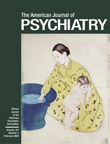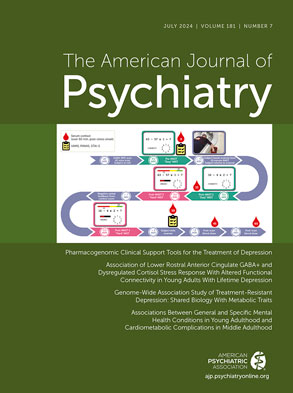To the Editor: We appreciate Dr. Prosnick’s comments; our response is primarily by way of clarification rather than disagreement. One minor point: our Q-factor analysis produced seven primary clusters or categories of personality disorders, of which one (dysphoric) had five subtypes that are more descriptive than the general cluster. Thus, the procedure indicated the existence of 11 distinct clusters of personality pathology, not far from the 10 listed under axis II disorders in DSM-IV. Several of these diagnostic groupings resemble current axis II categories, and in a multipart unpublished study, we describe some of the similarities and differences between our empirically generated prototypes and the categories and criteria selected by the DSM-IV Personality Disorders Work Group.
Aside from similarities and differences in content, perhaps the major difference between our empirically derived classification system and that found in DSM-IV, which we believe may suggest a revision for DSM-V, is a shift from a symptom-counting to a prototype-matching approach. Several features of a prototype-matching approach are advantageous. For example, in our article we noted the psychometric problems with diagnosing a disorder with eight items and counting them, such as the inherent comorbidity that would be built into such a system. A conceptual and practical advantage of having clinicians consider the gestalt and make a rating of the extent to which a patient matches the prototype of a disorder is that it is easier, is faster, probably is much more reliable (something we are now exploring empirically), and permits diagnoses that are both dimensional (degree of match to the prototype) and categorical (based on a cutoff above which a rating can be considered above the threshold for categorical diagnosis of the disorder, e.g., a rating of 5 on a scale of 1 to 7). A prototype-matching approach also does not require that clinicians try to dichotomize symptoms (present/absent) that are, by their nature, actually continuous (e.g., grandiosity, emotional lability, lack of empathy, lack of insight, fear of betrayal by others, and preoccupation with being criticized by others).
An equally important advantage of a prototype-matching system (particularly one in which the prototypes are empirically determined) is that a diagnostic criterion can, and should be, part of more than one diagnosis if it applies to more than one type of disorder. This would not lead to the inflated estimates of comorbidity that have plagued the list of axis II disorders in DSM-IV. When a prototype-matching approach is used with a larger number of criteria than eight per disorder, the meaning of any item reflects its embeddedness in a constellation of personality characteristics (the diagnostic criteria). Thus, one possible interpretation of the fact that the statement “Has little psychological insight into own motives, behavior, etc.” appeared on both the schizoid and antisocial diagnostic categories is, as Dr. Prosnick suggests, that the item reflects an underlying construct shared by the two. Another possibility, and one that may be complementary, is that the clinical significance and meaning of an item depends in part on the broader construct of which it is a part. For the schizoid patient, a lack of self-insight is part of a character style characterized by divorce from the human world and an avoidance of feelings, including one’s own. For the antisocial patient, a lack of self-insight may have more to do with an impulsive style that deters self-reflection or, if the patient has the functioning aspects of a conscience that gets overridden when impulses or affects are strong, promotes an effort to avoid reflecting on things that lead to guilt or shame.
With respect to Dr. Prosnick’s comments on the diagnostic profiles of narcissistic and obsessional personality pathology that emerged empirically, we are in no particular disagreement. Regarding narcissistic personality disorder, we suspect that a diagnosis that takes into account what the patient actually looks like over time—in particular, the patient’s phenomenology and not just overt self-reported symptoms—is likely to be more useful clinically, but that is an empirical question. The relatively healthy appearance of the obsessive patients in our study was an interesting and unexpected finding, as was the fact that the “sicker” obsessive patients, who appeared more like the DSM-IV axis II description of obsessive-compulsive personality disorder, all had an axis I diagnosis of obsessive-compulsive disorder, suggesting a confounding of the two disorders in DSM-IV (or at least in clinicians’ use of the manual). We are completing a cluster-analytic study of 60% of the patients treated in clinical practice for personality pathology not severe enough to warrant an axis II diagnosis but severe enough to require clinical attention
(1). The aim is to learn, empirically, about the categories or dimensions that define such patients with “neurotic” character pathology—that is, most patients who seek psychiatric help—for whom we currently have no diagnostic categories.
Finally, we agree with Dr. Prosnick’s comments about the importance of replication and theory-guided empiricism. As we noted in our article, our findings clearly need to be replicated with a less constrained study group. With respect to theory, there is no substitute for using theory—and particularly theory informed by clinical observation—in determining which items to include in an instrument such as the SWAP-200 Q-sort (on which our study was based). We included items based on personality theory, as well as clinical observation and empirical research, covering the ways in which different kinds of patients experience affect, styles of affect regulation, thought patterns, interpersonal patterns, their intrapsychic components, and the like. There is also no substitute for theory in selecting factor- or cluster-analytic solutions. Empirical procedures of the sort we used in our article are, we believe, essential for developing a more accurate, useful, and clinically valid system for assessing and classifying personality pathology, but they are of little value if they do not draw on the last century’s clinical and theoretical wisdom about personality and its pathology.

